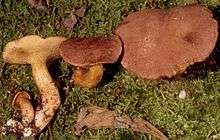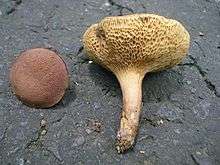Bothia
Bothia is a fungal genus in the family Boletaceae. A monotypic genus, it contains the single species Bothia castanella, a bolete mushroom first described scientifically in 1900 from collections made in New Jersey. Found in the eastern United States, Costa Rica, China, and Taiwan, it grows in a mycorrhizal association with oak trees. Its fruit body is chestnut brown, the cap is smooth and dry, and the underside of the cap has radially elongated tubes. The spore deposit is yellow-brown. The edibility of the mushroom is unknown. Historically, its unique combination of morphological features resulted in the transfer of B. castanella to six different Boletaceae genera. Molecular phylogenetic analysis, published in 2007, demonstrated that the species was genetically unique enough to warrant placement in its own genus.
| Bothia | |
|---|---|
 | |
| Scientific classification | |
| Kingdom: | |
| Division: | |
| Class: | |
| Order: | |
| Family: | |
| Genus: | Bothia Halling, T.J.Baroni & Manfr.Binder (2007) |
| Type species | |
| Bothia castanella (Peck) Halling, T.J.Baroni & Manfr.Binder (2007) | |
| Synonyms[1][2][3] | |
| |
| Bothia castanella | |
|---|---|
float | |
| pores on hymenium | |
| cap is convex or flat | |
| stipe is bare | |
| spore print is yellow-brown | |
| ecology is mycorrhizal | |
| edibility: unknown | |
Taxonomy
| ||||||||||||||||||||||||||||||||||||||||||||||||||||||
| Phylogeny of B. castanella and related boletus based on nuclear large subunit (LSU) ribosomal DNA sequences.[3] |
The bolete was first named Boletinus castanellus by American mycologist Charles Horton Peck in 1900. The type was collected in New Jersey by botanist Edward Sterling.[4] William Alphonso Murrill transferred it to Boletinellus in 1909; his generic concept of Boletinus included a ring on the stipe.[5] Rolf Singer placed it in Gyrodon in 1938,[6] while Wally Snell and Esther Dick thought the species to be more appropriately placed in Xerocomus, and transferred it to that genus in 1958.[7] Alexander H. Smith and Harry D. Thiers moved it to Suillus in their 1964 treatment of North American species.[8] In more recent history (1996), it has been moved to Chalciporus.[9] Snell and Dick's Boletinus squarrosoides (later moved by different authors to Phylloporus, Xerocomus, and Chalciporus)[10] is a facultative synonym (based on a different type) of B. castanella.[1] In their original 1936 publication, they compared the two species, and noted that Boletinus squarrosoides differed from B. castanellus by "reddish brown color, terete scaliness, and yellow colors of the flesh, tubes and stipe."[11] By 1958, after having examined additional collections, they realized that the two species were conspecific and represented morphological variations of each other.[7]
In 2007, Roy Halling and colleagues published molecular analysis showing that the species was genetically and morphologically distinct enough to deserve placement in a new Boletaceae genus, which they named Bothia. Since the original type has been lost, they designated a neotype from a collection made in Reading, Pennsylvania. Bothia is named in honor of mycologist Ernst E. Both, formerly curator emeritus of the Buffalo Museum of Science, and "promoter, facilitator and consummate student of boletology".[3] The specific epithet castanella, which means "small chestnut", refers to the color of the cap.[12]
Description

The cap of Bothia castanella is convex at first before flattening out in age, reaching a diameter of 3–8 cm (1.2–3.1 in). The center of the cap sometimes acquires a shallow depression, while the margin ranges from even to wavy and irregular. The cap surface is dry and initially hairy, but becomes smooth in maturity. Its color ranges from reddish brown to burgundy-brown to dark yellowish brown.[13] The flesh is white, and, unlike several other bolete species, does not change color when bruised or injured. It is about 8 mm (0.3 in) thick.[8]
On the cap undersurface are the pores, which are angular to elongated and measure about 2 mm wide. The color of the pore surface is pinkish brown to tan or buff, but it becomes yellowish brown in maturity; bruised areas turn ochre-tawny. The tubes are somewhat decurrent attached to the stipe (i.e., running slightly down its length), and extend about 6 mm (0.24 in) deep. The mushroom lacks any appreciable odor or taste. The dry, solid stipe measures 2–7 cm (0.8–2.8 in) long by 0.6–2 cm (0.2–0.8 in) thick, and is nearly equal in thickness throughout, or slightly tapered on either end. Its surface is more or less smooth except for a reticulate (meshed) area at the apex. The edibility of the mushroom is unknown.[13]
Fruit bodies produce a yellow-brown spore print. Spores are egg-shaped to ellipsoid, smooth, thin-walled, and measure 8.4–10.5 by 4.2–4.9 µm. The basidia (spore-bearing cells) are club-shaped, four-spored, and measure 25–35 by 7–9 µm. Cystidia are present on both the tube walls (as pleurocystidia) and abundantly on the edges (as cheilocystidia). They are somewhat spindle-shaped, sometimes with a central swelling, and measure 45–70 by 7–12 μm. Clamp connections are absent from the hyphae,[3] and all of the hyphae are inamyloid.[8]
Several chemical tests can used to help confirm identification of the mushroom. The cap cuticle turns grayish with the application of a drop of ferrous sulfate (FeSO4), and dark brown to amber with a dilute solution of potassium hydroxide (KOH). The flesh turns pale brown with KOH, and pale yellow with ammonia (NH4OH).[13]
Habitat and distribution
The fruit bodies of Bothia castanella grow singly, scattered, or in groups under oak, although other trees such as birch, beech, hickory, eastern white pine, and hemlock are sometimes present in the area.[3] Typical habitats include woods and parklands.[12] In Asia it has been recorded growing in bamboo forests.[14]
In the United States, where the fruiting season occurs from July to October,[13] its range extends from the Carolinas north to New York and New England, and west to Minnesota.[3] It has also been collected from Costa Rica,[9] China,[15] and Taiwan.[14]
References
- "Bothia castanella (Peck) Halling, T.J. Baroni & Manfr. Binder, Mycologia, 99 (2): 311, 2007". MycoBank. International Mycological Association. Retrieved 2013-09-16.
- "Synonymy: Bothia castanella (Peck) Halling, T.J. Baroni & Manfr. Binder, Mycologia 99(2): 311 (2007)". Index Fungorum. CAB International. 2013. Retrieved 2013-09-16.
- Halling RE, Baroni TJ, Binder M (2007). "A new genus of boletaceae from eastern North America". Mycologia. 99 (2): 310–6. doi:10.3852/mycologia.99.2.310. PMID 17682784.
- Peck CH. (1900). "New species of fungi". Bulletin of the Torrey Botanical Club. 27 (12): 609–13. doi:10.2307/2477998.
- Murrill WA. (1909). "The Boletaceae of North America". Mycologia. 1 (1): 4–18 (see p. 8). doi:10.2307/3753167.
- Singer R. (1938). "Sur les genres Ixocomus, Boletinus, Phylloporus, Gyrodon et Gomphidius. 2. Les Boletinus". Revue de Mycologie (in French). 3 (4–5): 157–77 (see p. 171).
- Snell WH, Dick EA (1958). "Notes on boletes: X. A few miscellaneous discussions and a new subspecies". Mycologia. 50 (1): 57–65. doi:10.2307/3756036. JSTOR 3756036.
- Smith AH, Thiers HD (1964). A Contribution Toward a Monograph of North American Species of Suillus (Boletaceae). pp. 26–7.
- Gómez LD. (1996). "Basidiomicetes de Costa Rica: Xerocomus, Chalciporus, Pulveroboletus, Boletellus, Xanthoconium (Agaricales: Boletaceae)". Revista de Biología Tropical (in Spanish). 44 (Suppl. 4): 59–89 (see p. 78.
- "Boletinus squarrosoides Snell & E.A. Dick, Mycologia, 28: 468, 1936". MycoBank. International Mycological Association. Retrieved 2013-09-16.
- Snell WH. (1936). "Notes on boletes. V". Mycologia. 28 (5): 463–75 (see p. 468). doi:10.2307/3754120.
- Roody WC. (2003). Mushrooms of West Virginia and the Central Appalachians. Lexington: University Press of Kentucky. p. 309. ISBN 0-8131-9039-8.
- Bessette AE, Roody WC, Bessette AR (2000). North American Boletes. Syracuse, New York: Syracuse University Press. pp. 233–4. ISBN 978-0-8156-0588-1.
- Chen C-M, Perng J-J, Yeh K-W (1997). "The boletes of Taiwan (VIII)" (PDF). Taiwania. 42 (4): 316–23. ISSN 0372-333X.
- Bi C-S, Loh T-C, Zheng G-Y (1982). "Basidiomycetes from Dinghu Mountain of China. 2. Some new species of Boletaceae". Acta Botanica Yunnanica (in Chinese). 4 (1): 55–64. ISSN 0253-2700.